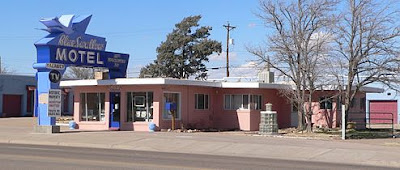Tucumcari,
New Mexico began as a railroad camp in 1901 when the Rock Island Railroad
decided to extend a line through New Mexico. The residents of Liberty (a small
town three miles north) saw the opportunity the rail line presented. They moved
southward closer to the rail line, and the camp became a tent city. It started
as a rowdy railroad camp filled with saloons, merchants, gamblers, dance hall
girls and outlaws.
Originally
called Ragtown, the camp became known as Six Shooter Siding, due to numerous gunfights. Its first formal
name, Douglas, was used only for a short time. One year later In 1908 it was
renamed Tucumcari after the scenic Tucumcari Mountains acting as a background
for the city. There are several legends behind the meaning of the word
"Tucumcari.” You can read about them in my previous blog post by CLICKING HERE.
The
fathers of Tucumcari were five business men from Liberty who filed on the land,
then donated 120 acres of land for town site. They were: M. B. Goldenberg, A.
D. Goldenberg, Jacob Wertheim, J. A. Street, and Lee K. Smith. J.A.
Street is credited for erecting the first tent in the new railroad camp.
The
first passenger train arrived in Tucumcari on March 12, 1902 and before long
there were four passenger trains arriving daily, two from the east and two from
the west.
One
of the first issues these early pioneers dealt with was the lack of water.
Initially, wells were dug into the hard ground, but failure to locate water
discouraged further drilling. Therefore, water had to be hauled into the new
settlement from the South Canadian River daily, costing the residents fifty
cents a barrel.
Some
of the first businesses to open in 1902 were the Waldorf-Astoria Hotel with
rooms for $2 a day, the Monarch Saloon, as well as many others baudy taverns, a
furniture store, a livery barn, a boarding house located at First and Turner
Streets, several mercantile stores, and the Exchange Bank. Max Goldenberg's
home was the first permanent home built in Tucumcari, which contained the post
office.
The
Elk Drug Store was established in 1906. It was owned by Drug Store Cowboy
Herman Moncus, who collected a mammoth assortment of items more or less
relating to the history of the area. He hung his collection from the ceiling of
his drug store.
At
this time New Mexico was one of the last territories available for settling. By
1907 arriving homesteaders had caused many small towns to crop up around
Tucumcari. By 1910, the town had expanded to include several churches, a school
system and over seventy businesses. Growth continued through the 1920s, brought
on by railroad and ranching opportunities. When the depression hit in 1930,
many of the smaller towns began to disappear, and the town's population began
to dwindle.
Primarily
thriving from the railroad and area ranching opportunities, the town continued
to prosper until the Great Depression era. At that time, most of the 20 some
small towns that surrounded the city were abandoned and quickly reverted to cow
pastures. With the development of Route 66 and the businesses it generated,
Tucumcari survived the depression.
In
1940, when the South Canadian River was dammed, this created some 60,000 acres
of irrigated farmland. What were once cow pastures soon became rich farmland,
pulling Tucumcari out of its slump.
Sources:
Legends of
America, Tucumcari, New Mexico, http://www.legendsofamerica.com/nm-tucumcari.html
Ballinger
Family History, Tucumcari, New Mexico - 1910-1920; http://history.fristad.net/ballenger/tucumcari_nm.shtml
Tucumcari,
NM; Wikipedia
Zina Abbott is the pen name used by Robyn
Echols for her historical novels. The first three novellas in the Eastern
Sierra Brides 1884 series, Big Meadows Valentine,
A Resurrected Heart, and Her Independent Spirit, are now available. He Is a Good Man was published as
part of the Lariats, Letters and Lace anthology.








No comments:
Post a Comment